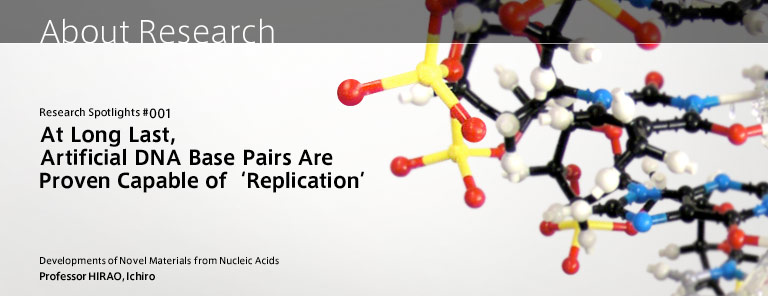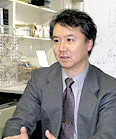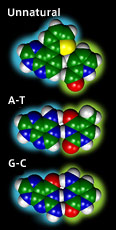- HOME
- Research
- Research Archives
- At Long Last, Artificial DNA Base Pairs Are Proven Capable of ‘Replication’
At Long Last, Artificial DNA Base Pairs Are Proven Capable of ‘Replication’

30 Years After the Double Helix
Ichiro Hirao developed an interest in genetics at the age of 19. A major turning point in his thinking came when he read Watson's the Double Helix at the recommendation of his supervisor. Professor Hirao, who had already begun learning techniques of organic synthesis at a college of technology at the time, resolved to investigate mechanisms related to DNA via the process of chemical synthesis. Thirty years have passed since that time. Currently, Hirao continues his research activities at both RCAST and RIKEN.
Time for a "Second Asilomar Conference"

-
All living creatures on earth have DNA in their cell nuclei. Four types of bases form pairs, and these pairs are linked together in a double helix structure. Professor Hirao has attempted to artificially synthesize an entirely new base pair. In order for a base pair integrated into DNA to function properly, three processes must take place. First, the DNA must replicate itself (‘replication’) during cell divisions. Then, messenger RNA (mRNA) must be synthesized based on the genetic information (‘transcription’). Finally, mRNA must be transported out of the nucleus and proteins built (‘translation’).

-
In 2002 Prof16essor Hirao’s group was the first in the world to succeed in artificially synthesizing a novel base pair that could be transcribed into mRNA and translated into protein in a test tube. Then, in the summer of 2005, the group made a further leap in progress when it created a base pair that could function in both ‘replication’ and ‘transcription.’ Now that ‘replication’ is possible, scientists can observe actual processes within cells--not only in the test tube.
For that reason alone, it is necessary to straighten out issues related to ethics. Thirty years have already passed since a conference was held in Asilomar to set guidelines for genetic recombination technology. Professor Hirao says that it will soon be necessary to hold a second Asilomar Conference.
Heading: Going Beyond Reason
It was a small failure in June that led to this summer's success. By chance, a staff member created an unexpected compound. When used in a trial, it produced surprisingly positive result.
Professor Hirao was surprised by this chance occurrence in such high-level research; yet, he has in fact had numerous previous experiences since his student days of chance playing an important role. “Anyone can work according to logic and reason. The things that we discover unexpectedly are the things that nobody thinks of, and that's what makes them so interesting.”

- The next major objective is to create an artificial base pair that functions in all three processes: ‘replication,’ ‘transcription,’ and ‘translation’. “When I work, I feel like I encounter ten failures for every success.” Indeed, trial and error remains an essential part of scientific research.
Following this summer's success, the lab staff took their first trip together in November and enjoyed a temporary break.
Interviewer: SUMIDA,Tomohisa
(October 25, 2005)

